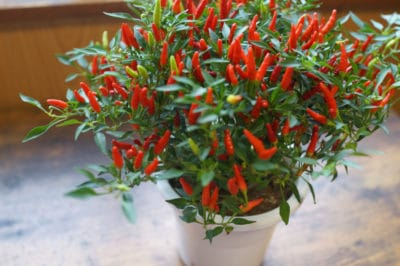Soil
The soil quality will determine the success of your plants. It is all they have to live in and the only source of initial nutrients. Choose an organic potting soil that is well-draining and rich in nutrients. Drainage is important to peppers. The soil must be able to hold enough moisture but drain the excess.
If you are unsure about the quality or cannot find organic potting soil, you can make some. Mix a 50/50 batch of peat and compost. Other additives that will benefit your plants include:
- Composted manure
- Sea Kelp
- Perlite
Container Size
Make sure the container you choose drains easily out the bottom. Line the bottom with rocks to avoid losing soil out of drainage holes. While a pepper plant cannot be in too big of a container, it can be convenient to start it in small containers and transplant it as it grows to save space.
For plants 12 inches tall and smaller, a two-gallon pot will work fine. Larger plants should be in five-gallon containers, and even larger plants may need ten-gallon containers. Some gardeners like to over-winter pepper plants keeping them as perennials for years. The plants reach formidable sizes and require very large pots.
Watering
The goal is to keep soil evenly moist but not wet. You can mulch containers to trap moisture in hot environments, and trim plants to encourage airflow in wet environments.
In temperatures of 65°F (18°C) plants will likely need daily watering. If it rises to 80°F (26°C) or above, they may need water twice a day.
Feeding
During a vegetative growth phase which comes before flowering, feed pepper plants every other week with a well-balanced organic fertilizer. Compost tea, seaweed extract, or fish emulsion all provide excellent nutrients.
When the plant begins to flower, it prefers less nitrogen and more phosphorus. A vermicompost top dressing or tea application goes a long way during the flowering phase.
Staking
It’s common for pepper plants to require support. They may become top heavy or weighed down with fruit. Use stakes or cages to support droopy limbs and hold the plant upright.
Caution
Guard pets, children, and yourself against the volatile oils in hot chili peppers. Just brushing past plants can cause severe irritation. Use gloves when handling them.
